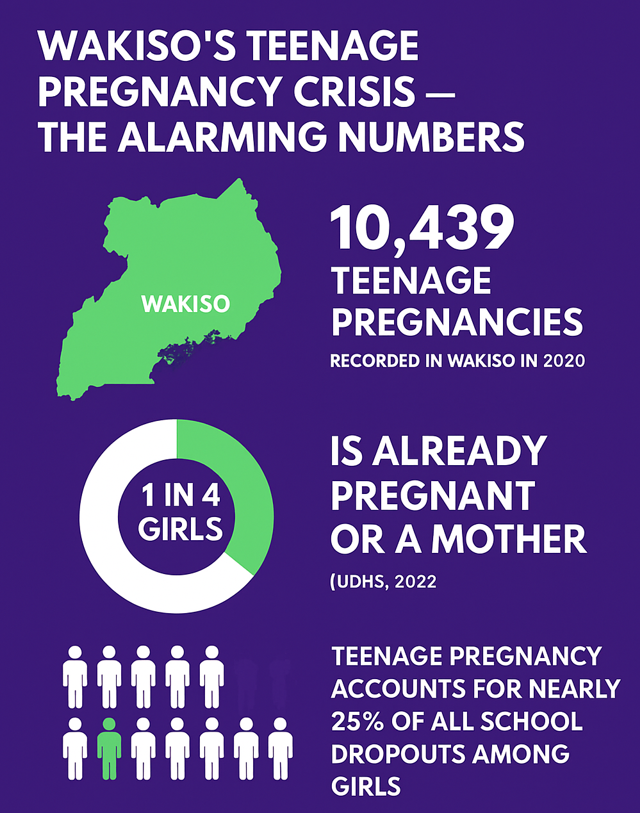At 17, Grace (not real name) is expected to be preparing for her Ordinary Level national examinations next year. But this hope now hangs in balance. She is now three months pregnant and can no longer attend school.
She has stumbled while in Senior Three, a year shy of completion of her O’Levels. It will take her about a year and half to bounce back to school, and this is only if she is lucky enough for the system to take her back.
Grace’s story mirrors a much bigger picture of Wakiso district, where teenage pregnancy stands as high as 28%, according to the United Nations Population Fund (UNFPA).
“I didn’t know I could get pregnant that easily,” she says softly. “We never had lessons about it at school. They only warned us to stay away from boys.” she said.
Teenage pregnancies and sexually transmitted infections (STIs) are rising in Uganda’s Wakiso District, pushing many girls out of school and exposing them to long-term health and economic risk.
Yet many schools remain reluctant to deliver Comprehensive Sexuality Education (CSE) due to cultural, religious and institutional resistance raising urgent questions about accountability in policy implementation.
This has cost the lives of many girls like Grace.
Grace’s story mirrors that of thousands of girls in Uganda’s most populous district where a silent crisis of teenage pregnancies, sexually transmitted infections (STIs) and lost futures are all compounded by the absence of Comprehensive Sexuality Education (CSE) in schools.

According to the Uganda Bureau of Statistics (UBOS) and UNICEF, Uganda records one of the highest adolescent pregnancy rates in Sub-Saharan Africa with data indicating that one in four (25%) girls aged 15–19 is pregnant or has had a child (UDHS 2022). According to a survey report released by Uganda Radio Network in 2021, Wakiso District alone registered 10,439 teenage pregnancies in 2020 which is one of the highest national totals ever registered.
According to the Ministry of Health’s 2023 report, there was increasing rates of STIs among adolescents, including chlamydia, gonorrhea and HIV reinfections, largely due to misinformation and low condom use. The World Health Organization in 2022 noted gaps in prevention education and declining condom use as key drivers of these trends and now the consequences for girls like Grace are devastating: school dropout, early motherhood, psychological trauma, and lifelong poverty.
Uganda’s National Sexuality Education Framework (2018), launched by the Ministry of Education and Sports with UNFPA Uganda, was designed to help young people like Grace to make informed choices about their sexual and reproductive health. However, implementation remains slow and inconsistent.
According to teachers in Wakiso, most schools do not deliver structured CSE lessons, citing lack of materials, fear of community backlash and no dedicated funding from the government.
“We were told to integrate it in science or religious studies,” said one teacher in Entebbe who preferred anonymity. “But there was no training or follow-up from the Ministry.”
This reluctance reflects a larger cultural and institutional resistance to open discussion about sexuality which is leaving many adolescents uninformed and vulnerable.
At Kigungu Health Centre II, a nurse shared that the number of young girls seeking antenatal care or STI treatment has “increased sharply since 2021.”
“We see many who don’t even know how pregnancy happens,” she said. “Some think you can’t get pregnant the first time.”
At community clinics like Alongside Hope’s “Girls and Women Lead” program, records show a 22.5% rise in teenage pregnancies among girls aged 10–24 in Wakiso District between March 2020 and June 2021 a figure that worsened during school closures and economic strain from COVID-19 lockdowns.
Many efforts to curb the growing situation have been hatched. Uganda’s National Strategy to End Child Marriage and Teenage Pregnancy (2022–2027) is one of them and this outlines bold targets though monitoring remains weak.
Experts and advocates agree that the solution lies not in policy creation, but in execution to curb adolescent pregnancies and STIs in Uganda.
Voices For Health and Development is one of the organizations that has come out to execute the equipping of students in schools and Universities with Sexual Reproductive Health and Rights information.
Mahoro Rose, Team leader at Voices argues that Comprehensive Sexuality Education is very key to reducing the risks early pregnancies and STIs.
“When young people have access to accurate information, they make safer choices. Silence and fear only expose them to risk. Comprehensive Sexuality Education is not a luxury — it’s a lifeline for our girls and Grace would perhaps not be in that situation now.” Said Rose
“Every statistic represents a life interrupted, a dream deferred. Grace’s story is a painful reminder that behind every teenage pregnancy is a system that failed to inform and protect. Uganda has strong policies on paper, but girls don’t live on paper, they live in communities. Until policies translate into practical change in schools and health systems, we are still failing them.” She added.
Grace’s dream is to become a nurse. But after becoming pregnant, her dreams seem shuttered in her third term of Senior Three.
“I still want to go back,” she says, “but I don’t know if they’ll accept me. People talk a lot.”
Her story embodies the cost of silence, a preventable tragedy born from fear, stigma and neglect.
Whereas other countries completely have no such policies, for Uganda the question is no longer if we should teach sexuality education.
It is when we will do it fully and how many more girls like Grace must pay the price before we act.
© 2022 - Media Challenge Initiative | All Rights Reserved .


